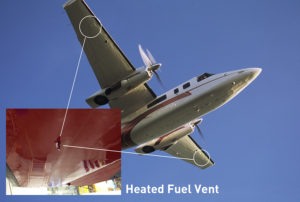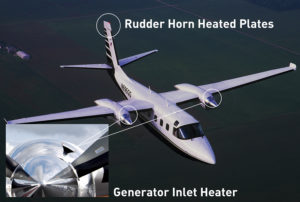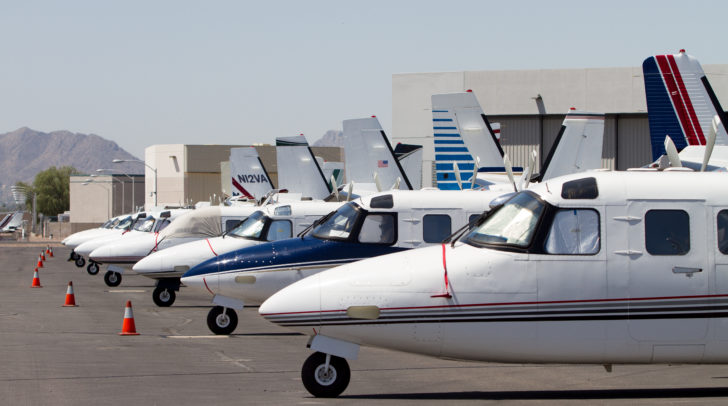HOW ICING CAN LEAD TO WING STALL
Spring is officially springing, and that means freezing temperatures and the weather phenomena associated with it—snow and ice—are fast disappearing. Except in the flight levels.
Airframe icing can be a real concern in the spring when ambient temperatures and moisture saturation aloft can be ideal for the formation of ice on wings and tail leading edges, propeller blades, engine inlets, and windshields.
As all pilots know, airframe icing is in the same category as thunderstorms as a flight condition to be treated with utmost respect. Knowledge is key to safely avoiding ice or dealing with it in an airplane approved for flight into known icing, as is the case with Turbo Commanders.
The FAA has just added to the icing knowledge base with a new “Ice-Induced Stall Pilot Training” film. Despite the government-gray title, there is much to learn in this 30-minute production, accessible on YouTube:
The film is an update of NASA’s original 1998 video on tailplane icing, and in the introduction the FAA says the update was prompted by a 30-year study of icing-related accidents that concluded that most such accidents resulted from wing stalls and not tail stalls. Thus, the film aims to help pilots understand the phenomenon of wing and tail stall while flying in icing conditions by examining icing certification rules and recommending cockpit procedures to mitigate the potential for icing-induced stalls.
Some interesting points made in the film:
- The majority of the general aviation fleet, including aircraft previously certified for flight into icing conditions, may not meet the latest icing certification standards. Many aircraft flying today were certified before the latest anti- and deice certification rules were enacted. A study of non-fatal ice-related upsets over the past 25 years found that the stall warning did not activate before a wing stall occurred. The study involved many different aircraft models in the cruise, approach, and landing phases of flight.
- The study concluded that an airplane’s susceptibility to tailplane stall may not be known, and that the stall warning system may not activate prior to a stall in icing conditions.
- An ice-contaminated wing increases stall speed significantly—as much as 20 knots.
- One of first signs of airframe icing is an increase in drag, resulting in the need for more power, loss of climb performance, and loss of airspeed.
- Tail stalls are very rare, but can occur, usually with full- or nearly-full flaps deployed, which moves the center of lift aft on the wing. Control forces will feel lighter, the pilot may have difficulty trimming, and could experience PIOs. The recovery from a tailplane stall is opposite that of a wing stall—pull back on the yoke, gradually reduce flaps, and decrease power.
The FAA is leading a rulemaking effort to both update training for wing-stall recognition and recovery, and cockpit procedures in icing conditions. In the meantime, devote 30 minutes to adding to your knowledge of, and respect for, airframe icing. Watch the film.
ANTI-ICING: MORE THAN WINDSHIELD AND PITOT-STATIC HEAT
Anti-ice measures on a turboprop Twin Commander protect lots more equipment than the windshield, pitot static probes, and engine inlets. Generator inlets and the rudder trim tab are protected by thermostatically controlled heated rubber boots. The fuel vent tubes are wrapped in a heated metal foil. And, the top of the horizontal stabilizer and bottom of the rudder horn have heated metal plates.
It’s important to make sure all of these components are in good condition and working properly before venturing into known icing. Generator inlets, for example, are located on the engine nacelle directly behind the prop and therefore subject to significant erosion. Fuel vent tubes are exposed to the slipstream and also suffer from erosion. The rudder trim tab and upper and lower rudder plates protect these surfaces from accumulation of ice between very closely spaced surfaces.
Checking and testing anti-ice components is best done by a Twin Commander-authorized service center, and not just because some of the components—the upper and lower rudder plates—are difficult to reach. Service centers are trained and equipped to test the components properly using the right tools and methods. Plus, they have access to improved versions of some of the components that have been developed recently by Twin Commander Aircraft LLC.


For more information about anti-ice components on your Twin Commander, contact your authorized Twin Commander Service Center.
FLIGHT LEVELS TAX LAW ARTICLE GOES VIRAL

A “Business Flying and Taxes” article in a recent issue of Twin Commander’s Flight Levels magazine on the effects of the new tax law on aircraft owners has gotten wide dissemination. The Global News Report wire service picked up the article and distributed it on its Twitter feed, and earned more than 2,700 impressions.
The article, written by Suzanne Meiners-Levy of the Advocate Consulting Legal Group, provides details on five areas of reform that directly impact business aircraft ownership and operation:
- Equipment Expensing for Purchases Made after September 27, 2017.
- Elimination of 1031 Exchanges for Equipment
- Adjustments to Deductibility of Flights Pursuant to Section 274
- Clarification of No Excise Tax for Part 91 Flights Pursuant to a Management Agreement
- Tax Rate Changes for C-Corporations for Pass-Through Entities
To read the full article, see:
Flight Levels Online

